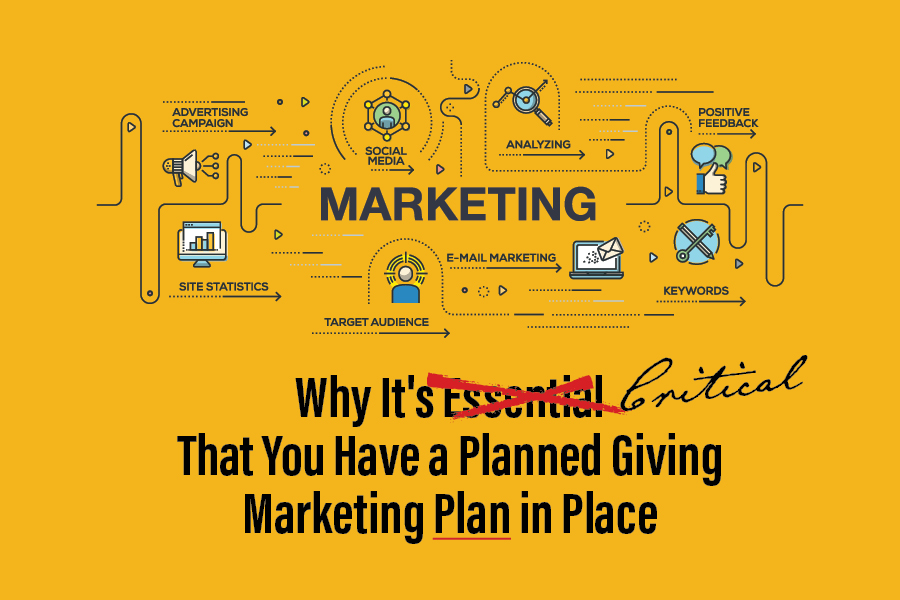You have a planned giving program — that’s great! You also have a website, occasionally send out a few marketing emails to donor prospects, and even have a flier to take on prospect visits.
But donations are sporadic. Your group has snagged a few bequests here and there; and maybe you’ve landed a donor-advised fund. Overall, though, “sales” are flat; those donations just aren’t coming in at the rate (or amount) you need. You’re beginning to wonder if prospective donors even know that your nonprofit exists.
It’s almost like your organization is existing in a vacuum.
Guess what? It is.
You see, you’re missing one essential ingredient:
A Planned Giving Marketing Plan
By now you’ve heard us use the phrase, “fail to plan, and you plan to fail.”
You’re failing to plan.
Let’s look at it from another angle. Imagine you need to drive from New York to California. Instead of creating a route using GPS (or, for those of you who are old-school, a map), you just jump in the car and drive.
You’re going to end up somewhere … but chances are, it’s not going to be where you intended. That’s what operating your planned giving program without a marketing plan is like.
Five Reasons Why
Here are five other reasons you need a planned giving marketing plan:
1. // Prospect Identification
Every business has an ideal customer prospect. Every nonprofit has an ideal donor prospect. Your organization needs to understand what drives your prospects to donate. Is it the idea of creating a lasting legacy? The thought of saving the environment? A desire to help children in need? A marketing plan helps you to identify those prospects and their motivation, then target your materials accordingly.
2. // Budget optimization
Operating without a marketing plan wastes money. Let’s go back to the cross-country drive metaphor for a minute. What’s the shortest distance between two points? A straight line. If you’re making random turns and zigzagging toward your destination, you’re going to burn up a lot more gas than you would by taking a direct route. Throwing money at a few Facebook ads here and a flier there does the same thing — burns up your budget without any real progress. A plan will allow you to set your budget and maximize your marketing ROI — return on investment.
3. // Brand Consistency
You do know your organization has a brand, right?
A brand is your identity. It’s what differentiates you from all the other organizations vying for donations. Your marketing materials should reflect that brand and send a consistent message. That helps prospects relate to your mission — which is the key to donations.
4. // Team Consistency
A marketing plan is a tangible product that can be presented to the entire team. From board members to gift officers, it’s a way to get everyone on the same page. It helps ensure consistent explanations of each planned giving product — no matter who’s doing the talking. Because in the end, everyone on your nonprofit’s team is responsible for the organization’s success.
5. // Goal Actualization
We’ll say it again: Fail to plan, and you plan to fail.
A marketing plan is the best way to ensure success. What’s your organization’s fundraising priority? Is it a building fund; scholarship; raising capital to purchase and preserve open space? Having a plan will allow you to identify and set priorities so the marketing budget goes to the right place. It’s the most efficient way to achieve your nonprofit’s goals.
Next Steps
Now that you know why your nonprofit needs a plan, let’s talk about the best way to create one: through a marketing audit.
An audit helps identify your organization’s marketing SWOT:
- Strengths
- Weaknesses
- Opportunities
- Threats.
In other words, what you’re doing right, what you’re doing wrong, what you could be doing, and what could have a negative affect on your nonprofit’s financial health.
A marketing audit will:
- Help you identify your target audience — because as we mentioned earlier, your nonprofit will appeal to a certain demographic. That’s where your money is.
- Evaluate your current branding.
- Evaluate your current marketing strategy.
- Review your objectives.
- Evaluate your competitors (yes, your nonprofit has competitors — namely, other nonprofits; and yes, possibly some for-profits).
- Create a game plan to move forward.
- Accelerate your organization’s growth.
Whether you hire us or do it inhouse with your team … Put. Something. Down. On. Paper.
Today.
::::::::::::::::::
Viken Mikaelian is the CEO and founder of PlannedGiving.com — the resource for all your planned giving marketing needs. Viken is available for speaking engagements on planned giving marketing, personal development and time management at viken.net.Share with your board:
The importance of planned giving from a financial perspective, and
The importance of planned giving from a strategic perspective.
Categories: Planned Giving Marketing, Marketing Planned Giving



